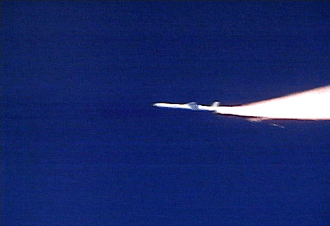NASA Tracks Navigation Errors, Fuel Shortage in DART Rendezvous Mission

DART, an$110 million experimental space mission designed to test automated dockingtechnology, ended prematurely late Friday after its launch from Vandenberg AirForce Base in California, NASA said today.
NASA's DART (Demonstration of Automated Rendezvous Technology) was launchedFriday at 1:25 p.m. EDT from a Pegasus rocket, which was released from aStargazer L-1011 aircraft at 40,000 feet over the Pacific Ocean.

During the subsequent rendezvous phase, "everything was working wonderful," hesaid. "We had high accuracy."
In orbit, DART was to fly around the Earth and rendezvous with an experimentalcommunications satellite launched in 1999. It was to get about 16 feet from thesatellite and perform several up-close maneuvers using a guidance sensor aboardDART and Global Positioning System satellite navigation information.
The 800-pound DART successfully met up with its target satellite and approachedwithin about 300 feet, but managers noticed it was using fuel too fast.
The guidance system sensed the empty fuel tank and commanded the spacecraft toretreat and enter the safe orbit that should lead it to burn up in theatmosphere within 10 years, Snoddy said.
DART was executing an engine burn that would put it in that orbit today.
Get the Space.com Newsletter
Breaking space news, the latest updates on rocket launches, skywatching events and more!
Snoddy wouldn't speculate why the craft lost fuel soquickly -- it started with enough to do all its maneuvers twice, plus a 30percent margin -- but said managers had not seen evidence of a leak.
NASA is forming a mishap investigation board to look into the failure.
Snoddy said some of DART'stechnology was proven in the aborted mission, but not the critical maneuversthat would demonstrate the ability of a spacecraft to dock without humanintervention.
"We've done what nobody's ever tried to do before," Snoddysaid of DART, which was "high risk" in that, to save money, it had limitedability to communicate or fix problems on the fly during its planned 24-hourmission.
Published under license from FLORIDA TODAY. Copyright ? 2005FLORIDA TODAY. No portion of this material may be reproduced in any waywithout the written consent of FLORIDATODAY.
Join our Space Forums to keep talking space on the latest missions, night sky and more! And if you have a news tip, correction or comment, let us know at: community@space.com.

Chris Kridler is a writer, editor, photographer and storm chaser who authored a group of storm-chasing adventure novels called Storm Seekers. As a reporter covering space, her subjects have included space shuttle missions, the Mars Rovers from California’s Jet Propulsion Lab, and a Soyuz launch and mission from Kazakhstan and Russia. Much of that work was published through her longtime column at Florida Today. Her photographs have been featured in magazines and books, including the covers of The Journal of Meteorology, the book Winderful, and the Wallace and Hobbs Atmospheric Science textbook. She has also been featured in Popular Photography. Kridler started chasing tornadoes in 1997, and continues the adventure every spring in Tornado Alley.









